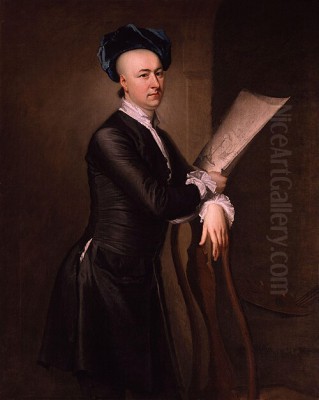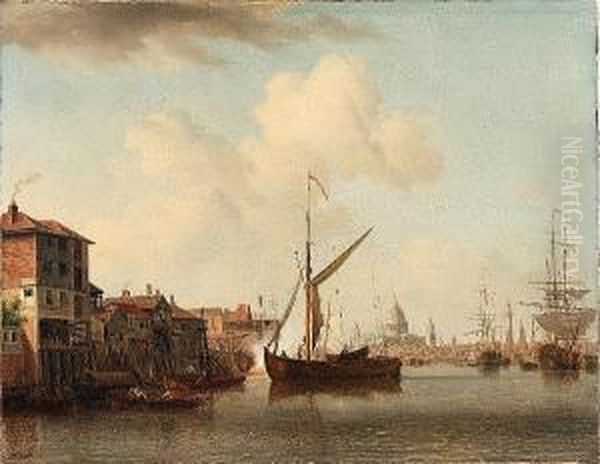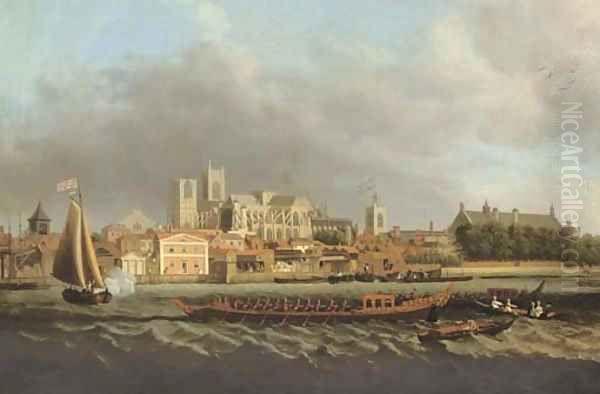
Samuel Scott stands as a pivotal figure in the development of British art during the 18th century. Born in London around 1702, he rose to prominence as one of the nation's foremost marine painters, while also making significant contributions to the genre of topographical view painting, particularly capturing the evolving landscape of his native city. His career bridges the gap between the established Dutch maritime tradition and the burgeoning native school of British painting, leaving behind a legacy of works admired for their accuracy, atmosphere, and historical significance. He died in Bath in 1772, leaving an indelible mark on how Britain viewed its naval power and its capital city.
Early Career and the Dutch Influence
Scott's artistic journey began under the pervasive influence of the Dutch Golden Age masters, particularly Willem van de Velde the Elder (1611-1693) and his son, Willem van de Velde the Younger (1633-1707). The Van de Veldes had worked in England and established a powerful precedent for marine painting, specializing in detailed ship portraits, dramatic naval battles, and serene calms. Scott, along with contemporaries like Peter Monamy (c. 1681-1749), emerged as one of the first significant native-born British artists to specialize in this genre following the Van de Veldes.
His early works clearly demonstrate this Dutch lineage. Scott meticulously studied the Van de Veldes' compositions and techniques, often creating pieces that directly emulated their style. He focused on naval subjects, depicting warships with careful attention to nautical detail, capturing the nuances of rigging, hull forms, and the play of light on water. These early marine paintings included ship portraits, depictions of naval engagements, and coastal scenes, often characterized by a calm, ordered composition and a cool palette, reflecting the Dutch aesthetic.

Scott quickly gained recognition for his skill in this area. He received commissions to record specific naval events and portray vessels, contributing to a growing national pride in Britain's maritime strength. His works from this period are valued not only for their artistic merit but also as historical documents, offering insights into the ships and naval practices of the time. He established himself as a leading practitioner of marine art in London, a city whose prosperity was deeply intertwined with the sea.
The Arrival of Canaletto and the Turn to Topography
A significant turning point in Scott's career occurred around the mid-1740s, coinciding with the arrival in London of the celebrated Venetian view painter, Giovanni Antonio Canal, better known as Canaletto (1697-1768). Canaletto arrived in 1746 and stayed, with interruptions, for nearly a decade. His luminous, detailed, and highly popular views of Venice had already influenced British tastes through Grand Tour acquisitions, and his presence in London created a sensation and a strong market for topographical paintings of the city.
While Scott did not abandon marine painting entirely, Canaletto's success clearly inspired him to explore topographical subjects, particularly views along the River Thames. He adapted his style, incorporating elements of Canaletto's approach – the clarity of light, the precision in architectural rendering, and the lively depiction of urban activity – but applied them to London scenes. Scott brought his own sensibilities to this genre, often infusing his views with a slightly softer atmosphere and a distinctly British character, different from the crystalline sharpness sometimes associated with Canaletto.
This shift proved highly successful. Scott found a ready market for his London views, which captured the dynamism of the capital during a period of significant growth and change. He painted numerous scenes along the Thames, documenting the construction of new landmarks like Westminster Bridge and capturing the bustling river traffic that was the lifeblood of the city. This move cemented his reputation and broadened his appeal beyond purely maritime circles.
Marine Masterpieces
Even as he embraced topographical painting, Samuel Scott continued to produce significant works depicting marine subjects throughout much of his career. His deep understanding of ships and the sea, honed during his early years studying the Dutch masters, remained evident. He painted numerous canvases depicting British naval power, ranging from formal ship portraits to dramatic scenes of naval warfare, reflecting Britain's frequent conflicts during the 18th century, including the War of Jenkins' Ear and the Seven Years' War.

His naval battle scenes were praised for their accuracy and drama. He captured the chaos and energy of combat at sea, depicting ships maneuvering, cannons firing, and the effects of smoke and weather. Works commemorating specific victories, such as actions involving Admiral Anson's fleet, were popular and served a patriotic function, celebrating the prowess of the Royal Navy. He often worked on commissions for naval officers or their families, ensuring a high degree of accuracy in the portrayal of specific ships and events.
Beyond battles, Scott also excelled at depicting calmer harbour scenes and coastal views. These works often showcase his skill in rendering the subtle effects of light on water and sky, and the varied textures of ships' timbers and sails. He captured the everyday life of ports, showing vessels at anchor, loading or unloading cargo, and interacting with smaller boats. These paintings demonstrate his versatility within the marine genre, moving beyond mere reportage to create evocative maritime landscapes. His contemporary, Charles Brooking (1723-1759), was another brilliant marine painter of the period, though his career was tragically short.
Chronicler of the Thames: Topographical Views
Samuel Scott's most enduring legacy arguably lies in his topographical views of London, particularly those centered on the River Thames. He became the foremost painter of the London riverside in the mid-18th century, creating a unique visual record of the city's waterfront architecture and bustling activity. His paintings serve as invaluable historical documents, capturing the appearance of landmarks before later alterations or demolitions.
Among his most famous subjects was Westminster Bridge. He painted the bridge multiple times, documenting its construction phase in the 1740s and its appearance upon completion. The Building of Westminster Bridge (c. 1749) shows the wooden centering used to construct the arches, a fascinating glimpse into 18th-century engineering. His later views, such as the celebrated An Arch of Westminster Bridge (c. 1750), often considered one of his masterpieces, use the structure as a framing device, offering glimpses of the river and city beyond, populated with boats and figures that bring the scene to life.
Scott painted many other iconic locations along the Thames, including London Bridge (before the removal of its houses), the Tower of London, Somerset House, and various views looking east or west along the river. The Thames at London Bridge and views incorporating York Buildings Water Tower or Montagu House showcase his ability to combine detailed architectural rendering with lively depictions of river traffic – barges, ferries, pleasure boats, and sailing vessels. These works capture the essence of the Thames as London's great thoroughfare. He also painted views of Covent Garden piazza, demonstrating his skill extended beyond the riverfront.
Artistic Style and Technique

Samuel Scott's style evolved throughout his career but consistently displayed certain characteristics. His draughtsmanship was typically precise and assured, particularly in the rendering of ships and architecture. He possessed a keen eye for detail, whether capturing the intricate rigging of a man-of-war or the specific architectural features of a London building. This accuracy lent his work a documentary quality highly valued by his contemporaries.
His handling of light and atmosphere is another key feature. In his marine paintings, he skillfully depicted the reflections on water, the changing conditions of the sky, and the way light defined the forms of ships. In his London views, influenced by Canaletto but distinct in feel, he often favoured a silvery, slightly diffused light that imbued the scenes with a specific sense of place and time – a recognizably English atmosphere, contrasting with the often brighter, sharper light of Venetian views.
Scott worked primarily in oils on canvas, employing techniques that allowed for both fine detail and broader atmospheric effects. His compositions are generally well-structured, often using architectural elements or the lines of the river to lead the viewer's eye into the scene. He populated his topographical views with numerous small figures and boats, adding life and scale to the urban landscape. While influenced by Dutch and Italian models, Scott forged a style that was ultimately his own, contributing significantly to the development of a native British school of painting.
Collaborations, Connections, and Reputation
Samuel Scott was well-connected within the London art world of his time. His friendship with the influential painter and satirist William Hogarth (1697-1764) is well-documented. In 1732, Scott, Hogarth, and three other friends embarked on a famous five-day journey, the "Peregrination," from London to the Isle of Sheppey in Kent, an event humorously chronicled by Hogarth and others. This connection undoubtedly helped solidify Scott's position in artistic circles.
He also collaborated with other artists. Notably, around 1732, he worked with the landscape painter George Lambert (1700-1765) on a series of large paintings depicting the settlements of the East India Company for their headquarters in Leadenhall Street. Lambert typically painted the landscapes, while Scott added the shipping. This collaboration highlights the specialized nature of painting at the time and Scott's pre-eminence in marine subjects.

Scott's reputation was high among connoisseurs and fellow artists. The writer and collector Horace Walpole (1717-1797), a key arbiter of taste, was a great admirer, owning several of Scott's works and praising him highly. Walpole compared Scott favourably to the Van de Veldes and declared that his London views, particularly those of Westminster Bridge, "will charm in every age." Such endorsements helped secure Scott's patronage and legacy. He exhibited works, likely including views associated with the popular Vauxhall Gardens (formerly Royal Spring Gardens). His circle would have included many leading figures of the day, potentially interacting with portraitists like Allan Ramsay (1713-1784) or the rising star Joshua Reynolds (1723-1792), and landscape pioneers like Richard Wilson (1714-1782), or narrative painters like Francis Hayman (c. 1708-1776).
Later Life and Legacy
Towards the end of his life, Samuel Scott's health began to decline, likely exacerbated by gout. Around 1765, he decided to leave the bustle and, perhaps, the damp air of London and retire to Bath, the fashionable spa town in Somerset. He settled in Walcot Street, seeking the health benefits of the town's waters and a quieter life.
His output appears to have significantly decreased during these later years in Bath. While he may have continued to paint occasionally, the major part of his life's work was completed by the time he left London. He died in Bath on October 12, 1772.
Samuel Scott's legacy is substantial. He is often hailed, alongside Peter Monamy, as the "Father of English Marine Painting," successfully adapting the dominant Dutch style and paving the way for later British marine artists like Dominic Serres (1719-1793) and J.M.W. Turner (1775-1851) in subsequent generations. His contribution to topographical painting is equally significant. He was the most important painter of London, particularly the Thames, in the mid-18th century, creating works that are both artistically accomplished and invaluable historical records.
His pupil, William Marlow (1740-1813), continued in the topographical tradition, influenced by Scott's style and choice of subject matter. Scott's paintings remain highly sought after and are held in major public collections worldwide, including Tate Britain, the National Maritime Museum in Greenwich, the Yale Center for British Art, and numerous other galleries, ensuring his enduring importance in the history of British art.
Conclusion: A Defining Vision of 18th-Century Britain
Samuel Scott occupies a crucial position in 18th-century British art. He masterfully navigated the transition from reliance on foreign models, particularly the Dutch marine tradition, to the establishment of a confident, native school of painting. His early works honour the legacy of the Van de Veldes, while his later topographical views respond creatively to the influence of Canaletto, resulting in a uniquely English interpretation of the urban landscape.
His paintings of the Royal Navy captured the spirit of an island nation increasingly defined by its maritime power. Simultaneously, his detailed and atmospheric views of London, especially the ever-changing River Thames, provide an unparalleled visual chronicle of the capital city during a period of dynamic growth. Admired in his own time by critics like Horace Walpole and artists like Hogarth, Scott's work continues to be valued for its historical accuracy, artistic skill, and evocative portrayal of Britain's maritime and urban identity. He remains a defining painter of his era, whose canvases offer compelling windows onto the world of 18th-century Britain.